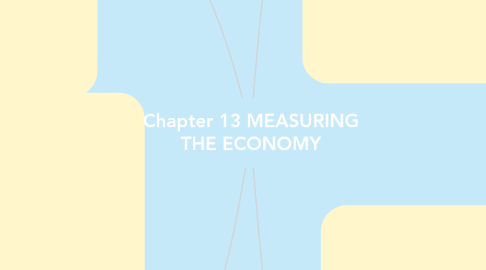Chapter 13 MEASURING THE ECONOMY
by QUINCY SIME

1. 13.2 How do Economists Measure the Size of the Economy
1.1. The main way economists measure a nation's economy is through its gross domestic product.
1.2. To calculate GDP, economics usually measure expenditures on goods and services produced in the country. Additionally, they divide the economy into four sectors: households, businesses, government, and foreign trade.
1.3. Economists use the GDP to identify how large an economy is, whether it is increasing and decreasing and at what rate, and to compare the economies with other individual countries.
1.4. GDP is an incredibly useful tool for economists to measure the economy, but there are many limitations. For example, it does not take into account illegal and informal exchanges.
1.5. gross domestic product: the market value of all final goods and services produced within a country during a given period of time
1.6. nominal GDP: the market value of all final goods and services produced within a country during a given period of time
2. 13.3 What Does the Unemployment Rate Tell Us About an Economy's Health?
2.1. Another useful indicator of the health of an economy is the unemployment rate. In general, a low unemployment rate means the overall health of the economy is good.
2.2. The Bureau of Labor Statistics is responsible for reporting the number and demographics of the people who are unemployed each month.
2.3. With the information the BLS gathers, four types of unemployment are gathered. They are frictional, structural, seasonal, and cyclical.
2.4. Just like GDP, there is no way to perfectly determine the unemployment of an economy because of a variety of problems. For example, unemployed workers may have given up looking for work, changing their title to discouraged workers.
2.5. unemployment rate: the percentage of the labor force that is not employed but is actively seeking work
2.6. natural rate of unemployment: the percentage of the labor force without work when the economy is at full employment; a condition in which the economy is strong and there is no cyclical unemployment
2.7. discouraged workers: unemployed workers who have ceased to look for work; discouraged workers are not considered part of the labor force and are not factored into the unemployment rate
3. 13.5 How Does the Business Cycle Relate to Economic Health?
3.1. There are four parts to the business cycle: contraction, peak, trough and expansion.
3.2. Business cycles are irregular and unpredictable. Economists do predict them by using a variety of indicators.
3.3. Business cycles are more commonly known as boom or bust. For example, the oil boom in western North Dakota is commonly thought of. Booms are the expansion phases, but eventually a bust occurs.
3.4. Very rarely, long periods of recession, bust, may occur. Economics commonly refer to these as depressions.
3.5. BUSINESS CYCLE
3.6. business cycle: a recurring pattern of growth and decline in economic activity over time
3.7. recession: a period of declining national economic activity, usually measured as a decrease in GDP for at least two consecutive quarters
4. 13.4 What Does the Inflation Rate Reveal About an Economy's Health?
4.1. A third indicator of the health of the economy is inflation rate. Economists monitor this closely after the historically high inflation rates that occurred in Germany after World War l.
4.2. The Bureau of Labor Statistics measures the inflation rate as well. They calculate this by measuring the cost of living by using the consumer price index.
4.3. Prices are constantly changing in today's world and can be identified as hyperinflation, creeping inflation or deflation.
4.4. Inflation can be causes in three ways: an increase in the money supply, an increase in the overall demand, and an increase in the cost of the factors of production.
4.5. inflation rate: the percentage increase in the average price level of goods and services from one month or year to the next
4.6. consumer price index: a measure of price changes in consumer goods and services over time; the CPI shows changes in the cost of living from year to year
4.7. deflation: a fall in the price of goods and services; the opposite of inflation
4.8. lkajdf


